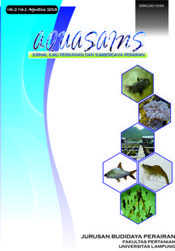ENZIM MANANASE DAN FERMENTASI JAMUR UNTUK MENINGKATKAN KANDUNGAN NUTRISI BUNGKIL INTI SAWIT PADA PAKAN IKAN NILA BEST (Oreochromis niloticus)
Abstract
Palm kernel meal is CPO (CrudePalm Oil)-by product are potentially as
an alternative raw material fish feed. This
research aims to know the influence of the
enzyme mananase and mold fermentation
to improve the quality of palm kernel over
the extent of the digestibility of oreochromis
BEST. This study used a Randomized
Complete design of experiment method
(RAL) with seven treatments and three replicates
each. BEST tilapia with weights 25
± 1.57 gram put in 21 60x40x40cm3 sized
aquarium. Test feed was given for 15 days
as a mortgage with a frequency three times
a day. The results showed that the total digestibility
(56,74%) and protein digestibility
(82,38%) resulting from the best treatment
of palm kernel with the addition of
mananase enzyme and fermentation of the
mold Rhizopus oligosporus and for carbohydrate
digestibility (60,72%) and energy
digestibility (71,82%) obtained the best result
from the treatment of palm kernel with
the addition of mananase enzyme and fermentation
of Trichoderma reesei mould.
Downloads
Download data is not yet available.
Downloads
Published
2013-08-12
How to Cite
Bakara, O., Santoso, L., & Heptarina, D. (2013). ENZIM MANANASE DAN FERMENTASI JAMUR UNTUK MENINGKATKAN KANDUNGAN NUTRISI BUNGKIL INTI SAWIT PADA PAKAN IKAN NILA BEST (Oreochromis niloticus). AQUASAINS, 2(1), 69–72. Retrieved from https://jurnal.fp.unila.ac.id/index.php/JPBP/article/view/199
Issue
Section
Articles
License
License for Authors
Authors who publish with this journal agree to the following terms:
- Authors retain copyright and grant the journal right of first publication with the work simultaneously licensed under a Creative Commons Attribution License that allows others to share the work with an acknowledgement of the work's authorship and initial publication in this journal.
- Authors are able to enter into separate, additional contractual arrangements for the non-exclusive distribution of the journal's published version of the work (e.g., post it to an institutional repository or publish it in a book), with an acknowledgement of its initial publication in this journal.
- When the article is accepted for publication, its copyright is transferred to Aquasains Journal. The copyright transfer convers the exclusive right to reproduce and distribute the article, including offprint, translation, photographic reproduction, microfilm, electronic material, (offline or online) or any other reproduction of similar nature.
- Authors are permitted and encouraged to post their work online (e.g., in institutional repositories or on their website) prior to and during the submission process, as it can lead to productive exchanges, as well as earlier and greater citation of published work (See The Effect of Open Access).
- The Author warrant that this article is original and that the author has full power to publish. The author sign for and accepts responsibility for releasing this material on behalf os any and all-author. If the article based on or part os student’s thesis, the student needs to sign as his/her agreement that his/her works is going published.
License for Regular Users
Other regular users who want to cite, distribute, remix, tweak, and build upon author’s works, even for commercial purposes, should acknowledge the work’s authorship and initial publication in this journal, licensed under a Creative Commons Attribution License.
This license lets others distribute, remix, tweak, and build upon your work, even commercially, as long as they credit you for the original creation.
This work is licensed under a Creative Commons Attribution 4.0 International License.Copyright Transfer Statement can be downloaded here


.png)









